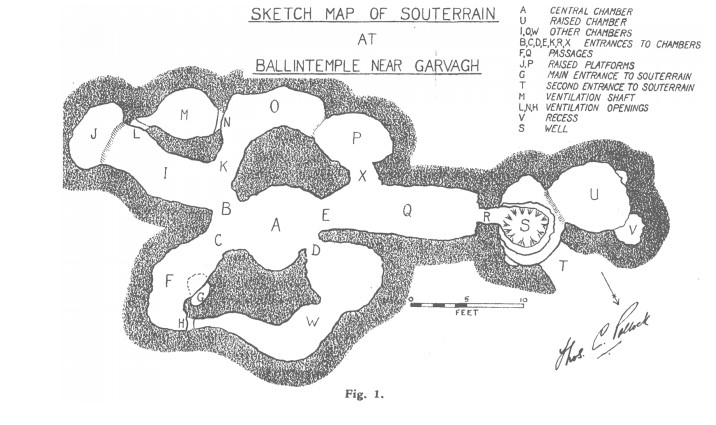Other Excavations – Rock-Hewn Souterrain, Ballintemple

Other Excavations – Sweat Houses of County Londonderry
24th March 2022
Other Excavations – A decorated bone case from Dreenan Bog
24th March 2022Other Excavations – Rock-Hewn Souterrain, Ballintemple
Rock-Hewn Souterrain, Ballintemple, Garvagh, County Londonderry
This souterrain beside the graveyard of Errigal ruined church in the Parish of Errigal and townland of Ballintemple was reopened by May and Cooper in 1933. They were assisted by local workmen to do the heavier work. ( Messers Daniel O’Kane, James and John Conway)
Mrs Heyland the landowner granted permission and facilitated the dig. It had first come to light in a booklet Friends and Foes written by Samuel Perry and describes how he and a companion set out to explore a cave on a hill near Errigal burial ground in 1834. They had entered the cave with candles to light their way and in places waded through water up to their chests, other passageways they had to crawl through and eventually they gave up when their candles were extinguished by what they thought to be gas.
Locals were unable to provide any further information though they were aware that a ‘cove’ existed and a passageway ran from it to the river about a quarter of a mile away, but no one could point out the entrances.
A search of the riverbank was fruitless, but when the owner’s son (Mr Cooper) probed the high ground with a crowbar. Mostly it hit rock except in one area about, 7 feet by 8 feet, that turned out to be loose soil and gravel, when this was removed it was found to be one of the roofless chambers of the souterrain. ( A on the plan)
With further digging four other chambers became visible with curving roofs (B,C,D,E on the plan). As the last of the soil was removed water was reached which prevented access to these other chambers. However using an improvised raft and lamp it was possible to examine parts of them. Six chambers were visible and water lay in three(S,O,I on the plan)
To fully explore the structures it was necessary to erect a pump to extract the water and this had to be moved several times . This was lent by Major H Flett, the engineer in charge of the Bann drainage contract. Overall it was found to be about 50 feet long by 24 feet broad with a number of chambers at different levels , narrow connecting passages and very small enterances , perhaps as a last defence against attack by invaders. The surveying of the site was undertaken by Mr T C Pollock.
The question of who made these structures, when and why are difficult to answer. It is most likely that they were used for protection. However the thick overlying sill of rock seems to have seriously detoriated since the souterrain was made, or they were made undermuch drier climatic conditions. This would date them between the 3rd and 10th centuries AD when Ireland last rrecorded a dry period. The other possibility is that this was an area of forest with screening branches and absorbing roots to prevent the penetration of the rain.
There were many objects found some from primitive time e.g. flints and oak logs similar to others found forming causeways through bogs. The sole of a small leather shoe and its upper were stated to be no earlier than the beginning of the 17th century by the National Museum in Dublin. Clubs and other roughly shaped flint tools suggest that those who built the souterrain were skilled in construction, but there is no evidence of fires or other remains.
References
May, A. McL, & Cooper,D.C. (1939). Rock-Hewn Souterrain, Ballintemple, Garvagh, County Londonderry.Ulster Journal of Archaeology, 2, 82–88. http://www.jstor.org/stable/20627269
Perry, S. (1834) Friends and Foes
For more information on Andrew May, explore the following links:
-
Andrew McLean May: Pioneer of local archaeology and horticulture
-
Andrew McL May and those who knew him
Other Andrew May excavations:
-
Bronze Age Burials, Knocknacart
-
Sweat Houses of County Londonderry
-
Rock-Hewn Souterrain, Ballintemple
-
A decorated bone case from Dreenan Bog
-
Some Wooden Utensils from Tyance, Moyagoney and Dreenan Bog
-
Pointed Bones, Flints and Stone Discs from the Lower Bann
-
Cloghnagalla Cairn
-
Cornacleary Round Cairn
-
A wooden javelin from Altinure
-
Two Cairns at Gortacloghan
-
Cremation Burials at Gortfad, Co. Londonderry
-
An Urn Burial at Slaghtaverty
-
Mountsandel, Lower Site
-
A Fine Spot for Fishing
-
Iron Age Pits, Camus Coleraine

